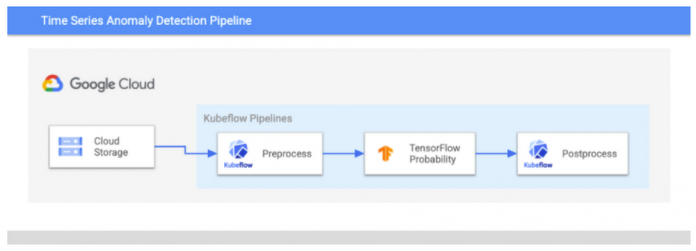Time series anomaly detection is currently a trending topic—statisticians are scrambling to recalibrate their models for retail demand forecasting and more given the recent drastic changes in consumer behavior. As an intern, I was given the task of creating a machine-learning based solution for anomaly detection on Vertex AI to automate these laborious processes of building time series models. In this article, you will get a glimpse into the kinds of hard problems Google interns are working on, learn more about TensorFlow Probability’s Structural Time Series APIs, and learn how to run jobs on Vertex Pipelines.
Vertex Pipelines
Vertex Pipelines is Google Cloud’s MLOps solutions to help you “automate, monitor, and govern your ML systems by orchestrating your ML workflows.” More specifically, our demo runs on the open source Kubeflow Pipelines SDK that can run on services such as Vertex Pipelines, Amazon EKS, and Microsoft Azure AKS. In this article we demonstrate how to use Vertex Pipelines to automate the process of analyzing new time series data, flagging anomalies, and analyzing these results. To learn more about Vertex Pipelines, read this article.
Google Cloud Pipeline Components
Google Cloud Pipeline Components is Kubeflow Pipeline’s new initiative to offer various solutions as components. Our time series anomaly detection component is the first applied ML component offered in this SDK. You can view our open source component in the SDK’s Github repo, and you can use the component by loading it via url.
Note that the component is in experimental mode and has not yet been officially released.
TensorFlow Probability Anomaly Detection API
TensorFlow Probability has a library of APIs for Structural Time Series (STS), a class of Bayesian statistical models that decompose a time series into interpretable seasonal and trend components.
Previously, users had to hand define the trend and seasonal components for their models, for example the demo uses a model with a local linear trend and month-of-year seasonal effect for CO2 concentration forecasting. In conjunction with this intern project, the TensorFlow Probability team built a new anomaly detection API where these components are inferred based on the input time series. This means that users can now do anomaly detection in one line of code:
This end-to-end API regularizes the input time series, infers a seasonal model, fits the model, and flags anomalies based on the predictive bounds of acceptable values. It is currently available in the TensorFlow Probability Github repository and will be included in the next official release. Our Google Cloud Pipeline Component packages this API onto the Vertex Pipelines ecosystem and demonstrates an example workflow using this anomaly detection algorithm.
Demo Notebook
In our demo, we benchmark the performance of the TensorFlow Probability anomaly detection algorithm on the NYC Taxi task from the Numenta Anomaly Benchmark. This dataset records the total number of NYC taxi passengers from July 2014 – January 2015 in 30-minute increments. There are ~10k data points and 5 anomalies that occur during events like Christmas and the NYC marathon.
Here we visualize the results of our pipeline. In the top graph, the black line marks the original time series of taxi passengers over time. The blue distribution marks the forecast distribution that the algorithm deems as likely given the previous time points, meaning any point above or below the forecast is flagged as anomalous. In the bottom graph, the black boxes mark the residual, i.e. the difference between the observed and expected counts of passengers. Here we see that there is a high residual on December 25th and the algorithm correctly flags the day as an anomaly.
We also run the custom scoring script from the Numenta Anomaly Benchmark on our predictions to compare the algorithm with others. We see that our algorithm performs the best on this NYC Taxi task as it is able to detect more anomalies with minimal false positives.
Conclusion
Want to start building your own time series models on Vertex AI? Check out the resources below to dive in:
Colab notebook for time series anomaly detection
Documentation on building your first KFP component
TensorFlow Probability blog post on Structural Time Series Modeling
TensorFlow Probability demo for Structural Time Series Modeling Case Studies
Cloud BlogRead More


